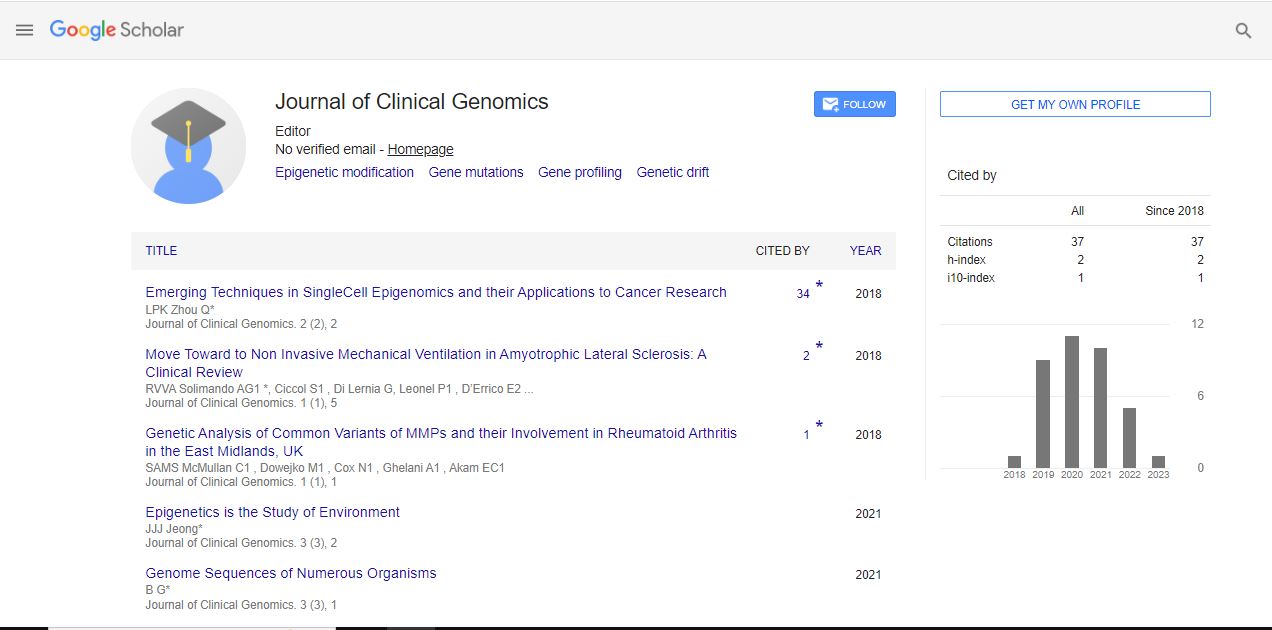About the Journal
Chromatography is nothing but the separation of mixtures. The liquid is immersed in a mobile phase fluid that takes it through a system that contains another material called the stationary phase. The mixture 's various constituents move at different velocities, allowing them to split. The separation is based on differential partitioning of the stationary and mobile processes. Subtle differences in the partition coefficient of a product result in differential retention on the stationary phase and therefore affect the separation. Chromatography may be either preparatory or analytical. Preparative chromatography has the function of separating the components of a mixture for later use, and is therefore a method of purification. Analytical chromatography is normally done with smaller amounts of material and is meant to determine the presence or the relative proportions of analytes in a mixture. The two aren't missing each other.
Gas chromatography varies from other types of chromatography in that the mobile phase is a gas that separates the materials as vapors.
Hence, it is used in the gas phase to separate and detect small molecular weight compounds.
The sample is either a vaporized gas or a liquid in the injection port. A carrier gas is the mobile process for gas chromatography, usually helium due to its low molecular weight and being chemically inert. Moreover, the pressure is applied and the analyte is pushed through the column by the mobile process. Separation is achieved using a stationary-phase coated column.
The gas chromatographic equilibrium is partitioning, and the sample components must partition (i.e. distribute) between the two phases: stationary phase and mobile phase.
Compounds with a greater affinity to the stationary phase spend more time in the column and therefore elute later and have a longer retention time (Rt) than compounds with a higher affinity for the mobile phase.
Stationary phase affinity is driven primarily by intermolecular interactions, and stationary phase polarity can be preferred to optimize interactions, and thus separation.
Ideal peaks are Gauussian distributions and symmetric due to the random nature of the column correlations between the analytes.
Chromatography method that uses paper sheets or strips as the adsorbent is called paper chromatography and is the stationary process in which a solution is allowed to move. It is a cheap way of distinguishing dissolved chemical compounds by their varying patterns of movement through paper sheets. It is a versatile analytical method that makes use of very small quantities of information. In the year 1943 Synge and Martin invented paper chromatography.
The theory concerned can be chromatography for partitioning or chromatography for adsorption. Chromatography partitioning as the compounds are separated or dispersed between the layers of liquids. The two stages are water that is placed in filter paper pores, and the other phase is a fluid stream that goes through the surface. The division of mixture happens as the mobile phase shifts. The compounds in the mixture distinguish under the capillary action of pores in the paper, depending on the variations in their affinity to stationary and mobile phase solvents. Chromatography of adsorption into solid and liquid phases, of which the rigid portion of the material is the stationary and the liquid phase is the mobile phase.
Journal of Chromatography Research(JCGR) is an international peer-reviewed, Open Access journal that provides a global platform for the exchange of knowledge regarding the theories and methodologies of Chromatography with a wide range of its application to research scholars, scientists to publish their theoretical research work and critical reviews on any field related to Chemistry, Biomedical, Physical Science, Applied Separation Techniques, etc. The Journal receives research, review papers, online letters to the editors & brief comments on the calculation and experimental procedures of previously published articles. This journal provides immediate open access to its content on the principle that making research freely available to the public.
Articles lodged by authors are evaluated by a group of peer review experts in the field and promises that the published articles are of high quality and that the information they contain is précised and genuine. Each and every step is to be taken to have a speedy and critical peer-review process. Some important scopes of this Journal are,
- The journal is not only focus on analytical equipment and its related technical procedures but also on methods of separation, identification and determination of substances in biochemistry, biotechnology, molecular biology, cell biology, clinical chemistry, pharmacology and related disciplines.
- Provides a platform for researchers worldwide to discuss the current issues and promote new developments in fundamentals, instrumentation and applications of chromatography over a broad range of products.
- Fundamental advances and applications in isolation and purification sciences in emerging field of Chromatography and novel research ideas will be particularly welcomed.
Journal of Chromatography Research focuses on the topics that include:
- Ion-exchange chromatography
- Analytical Chromatography
- Extraction Chromatography
- Capillary Electro chromatography
- Separation techniques of Local Anesthetics
- Reversed-phase chromatography
- Micellar electrokinetic chromatography
- High Performance Liquid Chromatography
- Supercritical Fluid Chromatography
- Gas Chromatography
- Liquid Chromatography
- Reversed Phase Chromatography
This journal provides the means to maximize the visibility, citations and readership which strengthen the impact of the research work and provides a range of recourse to procure our articles and also grants unlimited Internet Access to complete Journal content. There is no limitation on the length of the papers. The full experimental details must be provided so that the results can be reconstructed.
Chromatography
Chromatography can be used to separate delicate products. Chromatography is a very special separation process for so many reasons. Chromatography involves a sample being dispersed in a mobile phase (Such as liquid, gas or a supercritical fluid). The mobile phase is then allowed to go through an immobile, immiscible stationary phase. The phases are chosen in such a way that components of the sample must differ in their solubility in each phase. A component which takes more time to travel which is most utterly soluble in the stationary phase than a less soluble component in the stationary phase. As a result of these differences in mobilities, sample components will be separated from mixture as they travel through the stationary phase.
Gas chromatography
Gas chromatography is one of the analytical techniques used for separation and analyzing compounds. Prototypical uses of GC are to check the purity of a particular substance(Molecule or compound) or separation of the different components of a mixture. The sample solution enters a gas stream when injected into the instrument. It transports the sample into a separation tube known as the "column." (carrier gases used here are Helium or nitrogen) The inside the column various components get separated. A standard sample with known concentration is injected into the instrument for the measurement of a sample with an unknown concentration,. The standard sample peak retention time (appearance time) and area are compared to the test sample to calculate the concentration.
Liquid chromatography–mass spectrometry (LC-MS)
Liquid chromatography–mass spectrometry (LC-MS) is one of the analytical techniques. It is most often cited technique for the liquid chromatographers. This technique combines the resolving power of liquid chromatography with the detection specificity of mass spectrometry. Liquid chromatography (LC) introduces sample components into the mass spectrometer (MS) by separating them. The MS ionises the molecule and detects charged ions. Mass spectrometry provides structural identity of the individual components with high molecular specificity and detection sensitivity & liquid chromatography separates mixtures with multiple components. This spectroscopic technique is being used to analyze inorganic, organic, and biochemical compounds, commonly found in complex samples of biological and environmental origin.
High performance liquid chromatography (HPLC)
High performance liquid chromatography (HPLC) is basically a highly improved form of column liquid chromatography. It is an analytical technique used to separate, identify, and quantify each component in a mixture. Instead of a solvent being allowed to run through a column under gravity, it is forced through under high pressures (400 atm). That makes it much faster. Including HPLC all chromatographic separations works under the same basic principle; Because of the difference in the relative affinities of different molecules for the mobile phase and stationary phase used in this separation will separate the sample into its respective components.
Ion chromatography
Ion chromatography (or ion-exchange chromatography) basically separates the molecule into its ions and polar molecules based on their affinity to the ion exchanger. Most preferably it works any kind of charged molecule, including large proteins, small nucleotides, and amino acids. The two types of ion chromatography are anion-exchange and cation-exchange. It is often used in quality control, protein purification and water analysis.
Affinity chromatography
Affinity chromatography (AC) is an analytical technique used for the purification of a biomolecule with respect to individual chemical or structure biological function. Affinity chromatography is widely used for protein purification. AC is designed to purify a particular molecule from a mixed sample. In summary, It is a method that is designed to purify a particular molecule from a mixed sample so that we can carry out further investigation of this molecule.
Supercritical Fluid Chromatography
Supercritical Fluid Chromatography (SFC) is a form of normal phase chromatography, first used in 1962, which is used for the analysis and purification of low to moderate molecular weight, thermally labile molecules. It can also be used for the separation of chiral compounds. Principles are similar to those of high performance liquid chromatography (HPLC), however SFC typically utilizes carbon dioxide as the mobile phase; therefore the entire chromatographic flow path must be pressurized. Because this supercritical phase of being pressurized situation represents a state in which liquid and gas properties meets, it is sometimes called as “convergence chromatography”.
Fast Editorial Execution and Review Process (FEE-Review Process):
Journal of Chromatography Research is participating in the Fast Editorial Execution and Review Process (FEE-Review Process) with an additional prepayment of $99 apart from the regular article processing fee. Fast Editorial Execution and Review Process is a special service for the article that enables it to get a faster response in the pre-review stage from the handling editor as well as a review from the reviewer. An author can get a faster response of pre-review maximum in 3 days since submission, and a review process by the reviewer maximum in 5 days, followed by revision/publication in 2 days. If the article gets notified for revision by the handling editor, then it will take another 5 days for external review by the previous reviewer or alternative reviewer.
Acceptance of manuscripts is driven entirely by handling editorial team considerations and independent peer-review, ensuring the highest standards are maintained no matter the route to regular peer-reviewed publication or a fast editorial review process. The handling editor and the article contributor are responsible for adhering to scientific standards. The article FEE-Review process of $99 will not be refunded even if the article is rejected or withdrawn for publication.
The corresponding author or institution/organization is responsible for making the manuscript FEE-Review Process payment. The additional FEE-Review Process payment covers the fast review processing and quick editorial decisions, and regular article publication covers the preparation in various formats for online publication, securing full-text inclusion in a number of permanent archives like HTML, XML, and PDF, and feeding to different indexing agencies.
 Spanish
Spanish  Chinese
Chinese  Russian
Russian  German
German  French
French  Japanese
Japanese  Portuguese
Portuguese  Hindi
Hindi 


